It took me almost 20 years to get a diagnosis. My symptoms started at age 14 and came and went throughout my teens and 20’s. Finally, in my 30’s, the symptoms stayed and completely debilitated me. Most of the time, autoimmune arthritis diseases are chronic yet invisible diseases. There is always the phrase “But you don’t look sick” when you tell someone you have an autoimmune disease. When my disease hit me hard, it caused a pretty bad limp. I couldn’t hide my struggle. What was worse was that some days I limped and others I did not. I was questioned, talked about, and made to feel like I was a hypochondriac. I struggled with pain for almost 20 years before finding out the cause. I then met other patients who went through similar struggles. No one should have to wait 20 years for a diagnosis. No one should have to live with 20 years of damage from a disease that destroyed joints in the body making daily living skills almost impossible. I wanted to see a change but had no idea what to do!
I slowly entered the world of advocacy in 2009. I started out online in health forums on social media, then volunteered with IAAM and and cofounded IFAA. Soon I was doing public speaking engagements at health and pharmaceutical conferences. I was amazed that people wanted to hear my story. I accepted opportunities as they popped up and I learned so much from other patient advocates as they shared their stories. In 2013, I heard about an amazing way to share my story in rheumatology community: The American College of Rheumatology’s “Advocates for Arthritis” event. This is an annual event in which rheumatologists and patients from all over the United States, join forces to meet with members of Congress and the Senate to advocate for issues relating to the rheumatology community. I was chosen to represent the state of Pennsylvania with another RA patient, Margaret Storck. We were joined by a team of rheumatologists, Dr. Christina Downey, Dr. Prateek Gandiga (Fellow-in-Training), and Dr. Devon Storck (Fellow-in-Training).
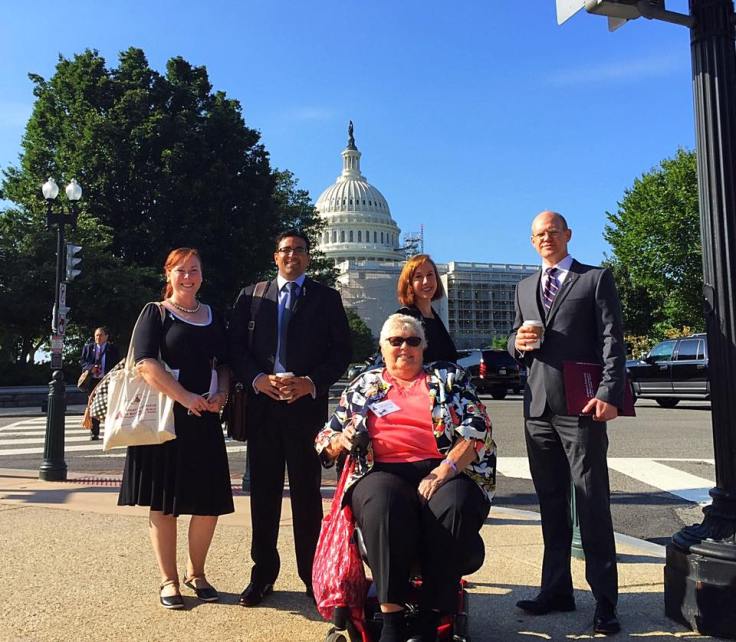
We met with two PA Senators and three Congressmen to discuss three issues pertaining to the rheumatology community.
The first issue we addressed was to urge the Center for Medicare and Medicaid Services (CMS) to significantly modify or withdraw the Part B Demo. This demonstration is proposed to drive down the cost of drugs; however, the reimbursement schedule would negatively impact many doctor’s offices from being able to continue in-office infusions. Learn more here: http://bit.ly/CMSpartb
The second issue we discussed was to ask Congress and the Senate to repeal the Medicare Therapy Cap. This cap would allow only $1960 allotted to patients who require physical therapy and/or speech therapy. Being a speech-language pathologist, this is an issue I am familiar with because it impacts people not only rheumatology patients, but also those suffering from stroke, ALS, MS and many others. Cutting off these essential therapy treatments is harmful and can lead to disability for many patients in the long run. See various organizations that are fighting against this issue: http://bit.ly/therapycap This is truly an issue that can negatively impact millions of Americans.
Finally, we asked the Congressmen and Senators to invest in medical research. We requested
- $20 million in funding for dedicated research program at the Department of Defense to better serve veterans and active service members living with rheumatoid disease. Arthritis is the second leading cause for men and women to be discharged from the military.
- $34.5 million in funding for the National Institute of Health for 2017 FY Labor, Health, and Human Services
- funding for NIH funding included in 21st Century Cures legislation
- $13 million in funding for the Centers of Disease Control and Prevention Arthritis Program in the FY 2017 Labor HHS- Appropriations Bill
Sounds like a lot of money, right? Did you know that Arthritis is the #1 cause of disability in the United States? Did you know that for every $1.00 invested in research the community makes $2.00 back? I didn’t know this, but am glad that I do now. Did you know that a many veterans are coming back from deployment seriously disabled by arthritis in their 20’s and 30’s as a direct result of the work they did protecting our country? Getting osteoarthritis at that age is not the norm. Did you know that the only treatment for people with osteo/degenerative arthritis is pain medication and eventual joint replacement? We need to have research find better treatments to prevent arthritis from becoming debilitating.
At every meeting, Peggy and I both shared our personal stories. We shared our struggles with medication, struggles with diagnosis and treatment, and how autoimmune arthritis diseases have impacted our daily lives. Our rheumatologists highlighted the need for research and the need to make medications more affordable/available to the patients. We wore bent forks on our clothing to represent the simple tasks that are hard for patients living with rheumatic diseases. 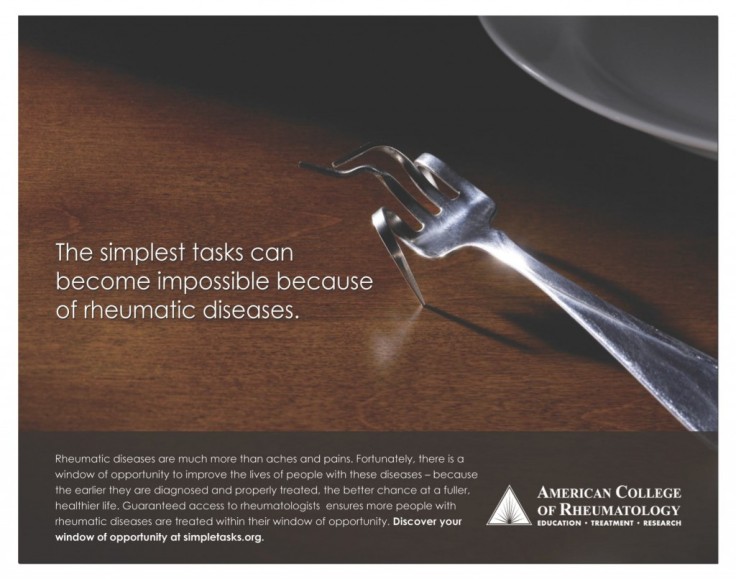
We mostly were well received by most of the legal aides we met. Some expressed concern over the cost of funding these bills BUT in reality we end up paying for the damage caused by arthritis in the long run. Wouldn’t it make more sense to be proactive to slow the damage and keep more Americans healthy? Well, I hope they see it that way. I will be following up with the liaisons I met to remind them how important these requests are for millions of Americans living with rheumatic disease.
The best part of this entire event was that I got to share it with my dear friends Lynn and Kevin and their son Sean, who was diagnosed with Ankylosing Spondylitis 4 years ago.
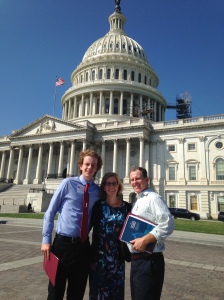
Sean is now a junior in high school. He is considering a career in pediatric rheumatology in the future. I’m so proud of this young man for taking up advocacy at such a young age. His impact on this event is probably bigger than he realizes. Many people do not know that children can also get arthritis which includes an autoimmune disease component. Sean’s presence on Capitol Hill opened many eyes to the realism of arthritis for millions of children. I am proud of you buddy! I’ve never had a chance to share my passion for advocacy with any of my close family and friends before, so their presence meant the world to me.
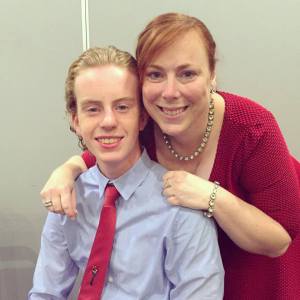
The only bad thing about this event is many patients never heard of the ACR Fly-in for Advocates for Arthritis. So I’m here to tell you…..make sure you apply next year!! This year 31 states were represented on Capitol Hill. How amazing would it be for all 50 states to have representation in the years to come! Request for applications usually come out in June each year.
I rested a lot prior to the event because it requires a lot of walking. I bought sensible shoes (kind of cute, too!) and rested a lot the night before so I would be ready to go. My legs started out like this: 
but ended up like this: 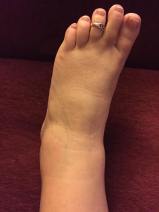
It was totally worth the pain and swelling.
This was my second time participating in this Fly-in and I can’t wait to participate again in the future. Thanks to the ACR for allowing me the opportunity to represent my state of Pennsylvania in Washington DC to advocate for my fellow #spoonies living the #chroniclife with various types of arthritis.
#Advocates4Arthritis






Thank you Kelly. I am thrilled you went.
LikeLiked by 1 person
Kelly
It was my pleasure to be your co patient advocate in Washington Hopefully Senators Toomey and Casey and Representatives Boyle Barletta and Meehan will help and endorse the blocking of part B demo ,the repeal of Medicare therapy caps and arthritis funding at NIH
Here’s looking forward to the day they find a cure for autoimmune diseases or at least find a drug to keep the pain away Looking forward to reading more of your blog and doing our advocacy in DC again next year.
LikeLiked by 1 person
Peggy, it was wonderful meeting you. You are an amazing advocate and it was a pleasure to be with you on Capitol Hill. Let’s keep in touch!
LikeLike
This is an amazing report. Thank you for sharing your experience on the Hill, and especially your experience as a patient, as a family member and a friend. Your report shows how important this work is, and why we need to continue it.
LikeLiked by 1 person